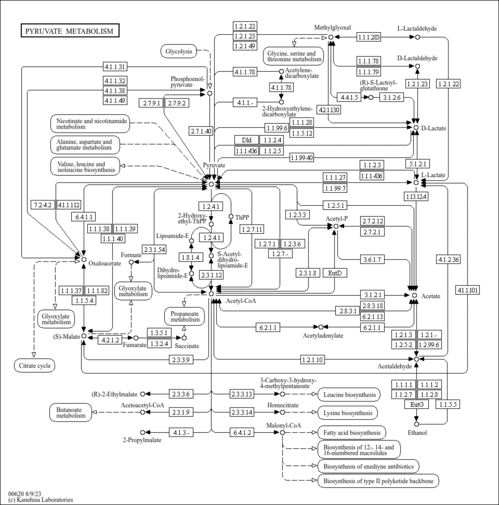| Record Information |
|---|
| Version | 5.0 |
|---|
| Status | Expected but not Quantified |
|---|
| Creation Date | 2008-08-14 17:04:10 UTC |
|---|
| Update Date | 2021-09-14 15:47:32 UTC |
|---|
| HMDB ID | HMDB0006878 |
|---|
| Secondary Accession Numbers | |
|---|
| Metabolite Identification |
|---|
| Common Name | S-Acetyldihydrolipoamide-E |
|---|
| Description | S-Acetyldihydrolipoamide-E belongs to the class of organic compounds known as fatty amides. These are carboxylic acid amide derivatives of fatty acids, that are formed from a fatty acid and an amine. Thus, S-acetyldihydrolipoamide-e is considered to be a fatty amide. Based on a literature review very few articles have been published on S-Acetyldihydrolipoamide-E. |
|---|
| Structure | InChI=1S/C10H19NO2S2/c1-8(12)15-7-6-9(14)4-2-3-5-10(11)13/h9,14H,2-7H2,1H3,(H2,11,13) |
|---|
| Synonyms | | Value | Source |
|---|
| 8-S-Acetyldihydrolipoamide | ChEBI | | Dihydrolipoyllysine-residue acetyltransferase]S-acetyldihydrolipoyllysine | HMDB |
|
|---|
| Chemical Formula | C10H19NO2S2 |
|---|
| Average Molecular Weight | 249.393 |
|---|
| Monoisotopic Molecular Weight | 249.085720237 |
|---|
| IUPAC Name | 8-(acetylsulfanyl)-6-sulfanyloctanamide |
|---|
| Traditional Name | 8-S-acetyldihydrolipoamide |
|---|
| CAS Registry Number | Not Available |
|---|
| SMILES | CC(=O)SCCC(S)CCCCC(N)=O |
|---|
| InChI Identifier | InChI=1S/C10H19NO2S2/c1-8(12)15-7-6-9(14)4-2-3-5-10(11)13/h9,14H,2-7H2,1H3,(H2,11,13) |
|---|
| InChI Key | WXCOTNFMLYTGPZ-UHFFFAOYSA-N |
|---|
| Chemical Taxonomy |
|---|
| Description | Belongs to the class of organic compounds known as fatty amides. These are carboxylic acid amide derivatives of fatty acids, that are formed from a fatty acid and an amine. |
|---|
| Kingdom | Organic compounds |
|---|
| Super Class | Lipids and lipid-like molecules |
|---|
| Class | Fatty Acyls |
|---|
| Sub Class | Fatty amides |
|---|
| Direct Parent | Fatty amides |
|---|
| Alternative Parents | |
|---|
| Substituents | - Fatty amide
- Carboxamide group
- Primary carboxylic acid amide
- Thiocarboxylic acid ester
- Carbothioic s-ester
- Sulfenyl compound
- Thiocarboxylic acid or derivatives
- Alkylthiol
- Carboxylic acid derivative
- Carbonyl group
- Organosulfur compound
- Organooxygen compound
- Organonitrogen compound
- Organic nitrogen compound
- Hydrocarbon derivative
- Organic oxide
- Organopnictogen compound
- Organic oxygen compound
- Aliphatic acyclic compound
|
|---|
| Molecular Framework | Aliphatic acyclic compounds |
|---|
| External Descriptors | |
|---|
| Ontology |
|---|
| Physiological effect | Not Available |
|---|
| Disposition | |
|---|
| Process | |
|---|
| Role | |
|---|
| Physical Properties |
|---|
| State | Solid |
|---|
| Experimental Molecular Properties | | Property | Value | Reference |
|---|
| Melting Point | Not Available | Not Available | | Boiling Point | Not Available | Not Available | | Water Solubility | Not Available | Not Available | | LogP | Not Available | Not Available |
|
|---|
| Experimental Chromatographic Properties | Not Available |
|---|
| Predicted Molecular Properties | | Show more...
|---|
| Predicted Chromatographic Properties | Predicted Collision Cross SectionsPredicted Kovats Retention IndicesUnderivatizedDerivatized| Derivative Name / Structure | SMILES | Kovats RI Value | Column Type | Reference |
|---|
| S-Acetyldihydrolipoamide-E,1TMS,isomer #1 | CC(=O)SCCC(CCCCC(N)=O)S[Si](C)(C)C | 2263.6 | Semi standard non polar | 33892256 | | S-Acetyldihydrolipoamide-E,1TMS,isomer #1 | CC(=O)SCCC(CCCCC(N)=O)S[Si](C)(C)C | 2177.4 | Standard non polar | 33892256 | | S-Acetyldihydrolipoamide-E,1TMS,isomer #1 | CC(=O)SCCC(CCCCC(N)=O)S[Si](C)(C)C | 3555.2 | Standard polar | 33892256 | | S-Acetyldihydrolipoamide-E,1TMS,isomer #2 | CC(=O)SCCC(S)CCCCC(=O)N[Si](C)(C)C | 2241.1 | Semi standard non polar | 33892256 | | S-Acetyldihydrolipoamide-E,1TMS,isomer #2 | CC(=O)SCCC(S)CCCCC(=O)N[Si](C)(C)C | 2121.0 | Standard non polar | 33892256 | | S-Acetyldihydrolipoamide-E,1TMS,isomer #2 | CC(=O)SCCC(S)CCCCC(=O)N[Si](C)(C)C | 2964.4 | Standard polar | 33892256 | | S-Acetyldihydrolipoamide-E,2TMS,isomer #1 | CC(=O)SCCC(CCCCC(=O)N[Si](C)(C)C)S[Si](C)(C)C | 2345.6 | Semi standard non polar | 33892256 | | S-Acetyldihydrolipoamide-E,2TMS,isomer #1 | CC(=O)SCCC(CCCCC(=O)N[Si](C)(C)C)S[Si](C)(C)C | 2351.5 | Standard non polar | 33892256 | | S-Acetyldihydrolipoamide-E,2TMS,isomer #1 | CC(=O)SCCC(CCCCC(=O)N[Si](C)(C)C)S[Si](C)(C)C | 2871.1 | Standard polar | 33892256 | | S-Acetyldihydrolipoamide-E,2TMS,isomer #2 | CC(=O)SCCC(S)CCCCC(=O)N([Si](C)(C)C)[Si](C)(C)C | 2307.3 | Semi standard non polar | 33892256 | | S-Acetyldihydrolipoamide-E,2TMS,isomer #2 | CC(=O)SCCC(S)CCCCC(=O)N([Si](C)(C)C)[Si](C)(C)C | 2239.3 | Standard non polar | 33892256 | | S-Acetyldihydrolipoamide-E,2TMS,isomer #2 | CC(=O)SCCC(S)CCCCC(=O)N([Si](C)(C)C)[Si](C)(C)C | 2896.2 | Standard polar | 33892256 | | S-Acetyldihydrolipoamide-E,3TMS,isomer #1 | CC(=O)SCCC(CCCCC(=O)N([Si](C)(C)C)[Si](C)(C)C)S[Si](C)(C)C | 2442.1 | Semi standard non polar | 33892256 | | S-Acetyldihydrolipoamide-E,3TMS,isomer #1 | CC(=O)SCCC(CCCCC(=O)N([Si](C)(C)C)[Si](C)(C)C)S[Si](C)(C)C | 2448.2 | Standard non polar | 33892256 | | S-Acetyldihydrolipoamide-E,3TMS,isomer #1 | CC(=O)SCCC(CCCCC(=O)N([Si](C)(C)C)[Si](C)(C)C)S[Si](C)(C)C | 2635.3 | Standard polar | 33892256 | | S-Acetyldihydrolipoamide-E,1TBDMS,isomer #1 | CC(=O)SCCC(CCCCC(N)=O)S[Si](C)(C)C(C)(C)C | 2516.0 | Semi standard non polar | 33892256 | | S-Acetyldihydrolipoamide-E,1TBDMS,isomer #1 | CC(=O)SCCC(CCCCC(N)=O)S[Si](C)(C)C(C)(C)C | 2416.6 | Standard non polar | 33892256 | | S-Acetyldihydrolipoamide-E,1TBDMS,isomer #1 | CC(=O)SCCC(CCCCC(N)=O)S[Si](C)(C)C(C)(C)C | 3541.4 | Standard polar | 33892256 | | S-Acetyldihydrolipoamide-E,1TBDMS,isomer #2 | CC(=O)SCCC(S)CCCCC(=O)N[Si](C)(C)C(C)(C)C | 2477.7 | Semi standard non polar | 33892256 | | S-Acetyldihydrolipoamide-E,1TBDMS,isomer #2 | CC(=O)SCCC(S)CCCCC(=O)N[Si](C)(C)C(C)(C)C | 2340.0 | Standard non polar | 33892256 | | S-Acetyldihydrolipoamide-E,1TBDMS,isomer #2 | CC(=O)SCCC(S)CCCCC(=O)N[Si](C)(C)C(C)(C)C | 3038.3 | Standard polar | 33892256 | | S-Acetyldihydrolipoamide-E,2TBDMS,isomer #1 | CC(=O)SCCC(CCCCC(=O)N[Si](C)(C)C(C)(C)C)S[Si](C)(C)C(C)(C)C | 2837.7 | Semi standard non polar | 33892256 | | S-Acetyldihydrolipoamide-E,2TBDMS,isomer #1 | CC(=O)SCCC(CCCCC(=O)N[Si](C)(C)C(C)(C)C)S[Si](C)(C)C(C)(C)C | 2735.8 | Standard non polar | 33892256 | | S-Acetyldihydrolipoamide-E,2TBDMS,isomer #1 | CC(=O)SCCC(CCCCC(=O)N[Si](C)(C)C(C)(C)C)S[Si](C)(C)C(C)(C)C | 2916.1 | Standard polar | 33892256 | | S-Acetyldihydrolipoamide-E,2TBDMS,isomer #2 | CC(=O)SCCC(S)CCCCC(=O)N([Si](C)(C)C(C)(C)C)[Si](C)(C)C(C)(C)C | 2796.6 | Semi standard non polar | 33892256 | | S-Acetyldihydrolipoamide-E,2TBDMS,isomer #2 | CC(=O)SCCC(S)CCCCC(=O)N([Si](C)(C)C(C)(C)C)[Si](C)(C)C(C)(C)C | 2646.9 | Standard non polar | 33892256 | | S-Acetyldihydrolipoamide-E,2TBDMS,isomer #2 | CC(=O)SCCC(S)CCCCC(=O)N([Si](C)(C)C(C)(C)C)[Si](C)(C)C(C)(C)C | 2992.7 | Standard polar | 33892256 | | S-Acetyldihydrolipoamide-E,3TBDMS,isomer #1 | CC(=O)SCCC(CCCCC(=O)N([Si](C)(C)C(C)(C)C)[Si](C)(C)C(C)(C)C)S[Si](C)(C)C(C)(C)C | 3151.8 | Semi standard non polar | 33892256 | | S-Acetyldihydrolipoamide-E,3TBDMS,isomer #1 | CC(=O)SCCC(CCCCC(=O)N([Si](C)(C)C(C)(C)C)[Si](C)(C)C(C)(C)C)S[Si](C)(C)C(C)(C)C | 2995.9 | Standard non polar | 33892256 | | S-Acetyldihydrolipoamide-E,3TBDMS,isomer #1 | CC(=O)SCCC(CCCCC(=O)N([Si](C)(C)C(C)(C)C)[Si](C)(C)C(C)(C)C)S[Si](C)(C)C(C)(C)C | 2860.8 | Standard polar | 33892256 |
| Show more...
|---|
